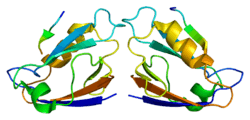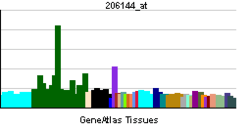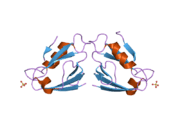MAGI1
| View/Edit Human | View/Edit Mouse |
Membrane-associated guanylate kinase, WW and PDZ domain-containing protein 1 is an enzyme that in humans is encoded by the MAGI1 gene.[3][4][5]
Function
The protein encoded by this gene is a member of the membrane-associated guanylate kinase homologue (MAGUK) family. MAGUK proteins participate in the assembly of multiprotein complexes on the inner surface of the plasma membrane at regions of cell–cell contact. The product of this gene may play a role as scaffolding protein at cell–cell junctions. Alternatively spliced transcript variants encoding different isoforms have been identified.[5]
Interactions
MAGI1 has been shown to interact with:
- ACCN3,[6]
- ATN1,[7]
- Actinin alpha 4,[8]
- Beta-catenin,[9]
- Brain-specific angiogenesis inhibitor 1,[3]
- Calcium-activated potassium channel subunit alpha-1,[10]
- FCHSD2,[11]
- LRP2,[12] and
- SYNPO.[8]
References
- ↑ "Human PubMed Reference:".
- ↑ "Mouse PubMed Reference:".
- 1 2 Shiratsuchi T, Futamura M, Oda K, Nishimori H, Nakamura Y, Tokino T (Jun 1998). "Cloning and characterization of BAI-associated protein 1: a PDZ domain-containing protein that interacts with BAI1". Biochemical and Biophysical Research Communications. 247 (3): 597–604. doi:10.1006/bbrc.1998.8603. PMID 9647739.
- ↑ Margolis RL, Abraham MR, Gatchell SB, Li SH, Kidwai AS, Breschel TS, Stine OC, Callahan C, McInnis MG, Ross CA (Jul 1997). "cDNAs with long CAG trinucleotide repeats from human brain". Human Genetics. 100 (1): 114–22. doi:10.1007/s004390050476. PMID 9225980.
- 1 2 "Entrez Gene: MAGI1 membrane associated guanylate kinase, WW and PDZ domain containing 1".
- ↑ Hruska-Hageman AM, Benson CJ, Leonard AS, Price MP, Welsh MJ (Nov 2004). "PSD-95 and Lin-7b interact with acid-sensing ion channel-3 and have opposite effects on H+- gated current". The Journal of Biological Chemistry. 279 (45): 46962–8. doi:10.1074/jbc.M405874200. PMID 15317815.
- ↑ Wood JD, Yuan J, Margolis RL, Colomer V, Duan K, Kushi J, Kaminsky Z, Kleiderlein JJ, Sharp AH, Ross CA (Jun 1998). "Atrophin-1, the DRPLA gene product, interacts with two families of WW domain-containing proteins". Molecular and Cellular Neurosciences. 11 (3): 149–60. doi:10.1006/mcne.1998.0677. PMID 9647693.
- 1 2 Patrie KM, Drescher AJ, Welihinda A, Mundel P, Margolis B (Aug 2002). "Interaction of two actin-binding proteins, synaptopodin and alpha-actinin-4, with the tight junction protein MAGI-1". The Journal of Biological Chemistry. 277 (33): 30183–90. doi:10.1074/jbc.M203072200. PMID 12042308.
- ↑ Dobrosotskaya IY, James GL (Apr 2000). "MAGI-1 interacts with beta-catenin and is associated with cell-cell adhesion structures". Biochemical and Biophysical Research Communications. 270 (3): 903–9. doi:10.1006/bbrc.2000.2471. PMID 10772923.
- ↑ Ridgway LD, Kim EY, Dryer SE (Jul 2009). "MAGI-1 interacts with Slo1 channel proteins and suppresses Slo1 expression on the cell surface". American Journal of Physiology. Cell Physiology. 297 (1): C55–65. doi:10.1152/ajpcell.00073.2009. PMC 3774261
 . PMID 19403801.
. PMID 19403801. - ↑ Ohno H, Hirabayashi S, Kansaku A, Yao I, Tajima M, Nishimura W, Ohnishi H, Mashima H, Fujita T, Omata M, Hata Y (Nov 2003). "Carom: a novel membrane-associated guanylate kinase-interacting protein with two SH3 domains". Oncogene. 22 (52): 8422–31. doi:10.1038/sj.onc.1206996. PMID 14627983.
- ↑ Patrie KM, Drescher AJ, Goyal M, Wiggins RC, Margolis B (Apr 2001). "The membrane-associated guanylate kinase protein MAGI-1 binds megalin and is present in glomerular podocytes". Journal of the American Society of Nephrology. 12 (4): 667–77. PMID 11274227.
Further reading
- Pirozzi G, McConnell SJ, Uveges AJ, Carter JM, Sparks AB, Kay BK, Fowlkes DM (Jun 1997). "Identification of novel human WW domain-containing proteins by cloning of ligand targets". The Journal of Biological Chemistry. 272 (23): 14611–6. doi:10.1074/jbc.272.23.14611. PMID 9169421.
- Dobrosotskaya I, Guy RK, James GL (Dec 1997). "MAGI-1, a membrane-associated guanylate kinase with a unique arrangement of protein-protein interaction domains". The Journal of Biological Chemistry. 272 (50): 31589–97. doi:10.1074/jbc.272.50.31589. PMID 9395497.
- Wood JD, Yuan J, Margolis RL, Colomer V, Duan K, Kushi J, Kaminsky Z, Kleiderlein JJ, Sharp AH, Ross CA (Jun 1998). "Atrophin-1, the DRPLA gene product, interacts with two families of WW domain-containing proteins". Molecular and Cellular Neurosciences. 11 (3): 149–60. doi:10.1006/mcne.1998.0677. PMID 9647693.
- Dobrosotskaya IY, James GL (Apr 2000). "MAGI-1 interacts with beta-catenin and is associated with cell-cell adhesion structures". Biochemical and Biophysical Research Communications. 270 (3): 903–9. doi:10.1006/bbrc.2000.2471. PMID 10772923.
- Patrie KM, Drescher AJ, Goyal M, Wiggins RC, Margolis B (Apr 2001). "The membrane-associated guanylate kinase protein MAGI-1 binds megalin and is present in glomerular podocytes". Journal of the American Society of Nephrology. 12 (4): 667–77. PMID 11274227.
- Dobrosotskaya IY (May 2001). "Identification of mNET1 as a candidate ligand for the first PDZ domain of MAGI-1". Biochemical and Biophysical Research Communications. 283 (4): 969–75. doi:10.1006/bbrc.2001.4880. PMID 11350080.
- Laura RP, Ross S, Koeppen H, Lasky LA (May 2002). "MAGI-1: a widely expressed, alternatively spliced tight junction protein". Experimental Cell Research. 275 (2): 155–70. doi:10.1006/excr.2002.5475. PMID 11969287.
- Patrie KM, Drescher AJ, Welihinda A, Mundel P, Margolis B (Aug 2002). "Interaction of two actin-binding proteins, synaptopodin and alpha-actinin-4, with the tight junction protein MAGI-1". The Journal of Biological Chemistry. 277 (33): 30183–90. doi:10.1074/jbc.M203072200. PMID 12042308.
- Ohno H, Hirabayashi S, Kansaku A, Yao I, Tajima M, Nishimura W, Ohnishi H, Mashima H, Fujita T, Omata M, Hata Y (Nov 2003). "Carom: a novel membrane-associated guanylate kinase-interacting protein with two SH3 domains". Oncogene. 22 (52): 8422–31. doi:10.1038/sj.onc.1206996. PMID 14627983.
- Hruska-Hageman AM, Benson CJ, Leonard AS, Price MP, Welsh MJ (Nov 2004). "PSD-95 and Lin-7b interact with acid-sensing ion channel-3 and have opposite effects on H+- gated current". The Journal of Biological Chemistry. 279 (45): 46962–8. doi:10.1074/jbc.M405874200. PMID 15317815.
- Wright GJ, Leslie JD, Ariza-McNaughton L, Lewis J (Nov 2004). "Delta proteins and MAGI proteins: an interaction of Notch ligands with intracellular scaffolding molecules and its significance for zebrafish development". Development. 131 (22): 5659–69. doi:10.1242/dev.01417. PMID 15509766.
- Benzinger A, Muster N, Koch HB, Yates JR, Hermeking H (Jun 2005). "Targeted proteomic analysis of 14-3-3 sigma, a p53 effector commonly silenced in cancer". Molecular & Cellular Proteomics. 4 (6): 785–95. doi:10.1074/mcp.M500021-MCP200. PMID 15778465.
- Mizuhara E, Nakatani T, Minaki Y, Sakamoto Y, Ono Y, Takai Y (Jul 2005). "MAGI1 recruits Dll1 to cadherin-based adherens junctions and stabilizes it on the cell surface". The Journal of Biological Chemistry. 280 (28): 26499–507. doi:10.1074/jbc.M500375200. PMID 15908431.
- Patrie KM (Aug 2005). "Identification and characterization of a novel tight junction-associated family of proteins that interacts with a WW domain of MAGI-1". Biochimica et Biophysica Acta. 1745 (1): 131–44. doi:10.1016/j.bbamcr.2005.05.011. PMID 16019084.
- Bratt A, Birot O, Sinha I, Veitonmäki N, Aase K, Ernkvist M, Holmgren L (Oct 2005). "Angiomotin regulates endothelial cell-cell junctions and cell motility". The Journal of Biological Chemistry. 280 (41): 34859–69. doi:10.1074/jbc.M503915200. PMID 16043488.
- Sakurai A, Fukuhara S, Yamagishi A, Sako K, Kamioka Y, Masuda M, Nakaoka Y, Mochizuki N (Feb 2006). "MAGI-1 is required for Rap1 activation upon cell-cell contact and for enhancement of vascular endothelial cadherin-mediated cell adhesion". Molecular Biology of the Cell. 17 (2): 966–76. doi:10.1091/mbc.E05-07-0647. PMC 1356604
 . PMID 16339077.
. PMID 16339077.
This article is issued from Wikipedia - version of the 5/20/2016. The text is available under the Creative Commons Attribution/Share Alike but additional terms may apply for the media files.


